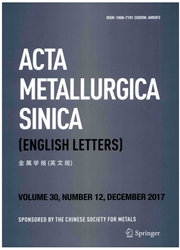

 中文摘要:
中文摘要:
Isothermal hot compression tests of as-cast high-Cr ultra-super-critical(USC) rotor steel with columnar grains perpendicular to the compression direction were carried out in the temperature range from 950 to 1250°C at strain rates ranging from 0.001 to 1 s-1. The softening mechanism was dynamic recovery(DRV) at 950°C and the strain rate of 1 s-1, whereas it was dynamic recrystallization(DRX) under the other conditions. A modified constitutive equation based on the Arrhenius model with strain compensation reasonably predicted the flow stress under various deformation conditions, and the activation energy was calculated to be 643.92 kJ ×mol-1. The critical stresses of dynamic recrystallization under different conditions were determined from the work-hardening rate(θ)–flow stress(σ) and-θ/σ–σ curves. The optimum processing parameters via analysis of the processing map and the softening mechanism were determined to be a deformation temperature range from 1100 to 1200°C and a strain-rate range from 0.001 to 0.08 s-1, with a power dissipation efficiency η greater than 31%.
 英文摘要:
英文摘要:
Isothermal hot compression tests of as-cast high-Cr ultra-super-critical(USC) rotor steel with columnar grains perpendicular to the compression direction were carried out in the temperature range from 950 to 1250°C at strain rates ranging from 0.001 to 1 s~(-1). The softening mechanism was dynamic recovery(DRV) at 950°C and the strain rate of 1 s~(-1), whereas it was dynamic recrystallization(DRX) under the other conditions. A modified constitutive equation based on the Arrhenius model with strain compensation reasonably predicted the flow stress under various deformation conditions, and the activation energy was calculated to be 643.92 kJ ×mol~(-1). The critical stresses of dynamic recrystallization under different conditions were determined from the work-hardening rate(θ)–flow stress(σ) and-θ/σ–σ curves. The optimum processing parameters via analysis of the processing map and the softening mechanism were determined to be a deformation temperature range from 1100 to 1200°C and a strain-rate range from 0.001 to 0.08 s~(-1), with a power dissipation efficiency η greater than 31%.
 同期刊论文项目
同期刊论文项目
 同项目期刊论文
同项目期刊论文
 期刊信息
期刊信息
